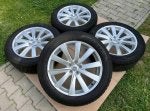

2020 XC90 T6 inscription with air suspension. It came with the 21" standard XC90 inscription wheels that are have the factory scorpion Verde 275/45/21 tires.
I bought a set of 19" 2018 XC90 turbine wheels for less than the cost of the 235/55/19 Yokohama tires they came with.
Since the 19" wheel is a stock wheel, I don't think I'll have any issues other than needing to have the speedometer recalibrated and related software updated right? These wheels don't have the ABS sensor, which is fine since my car senses speed off the wheel speed/abs sensor.
I would expect that I would have a softer ride and better fuel economy. I expect it won't be a snazzy looking as original lower profile wheel and tires that came on the car.
I would expect it would be harder to scuff the wheels on curbs.
Do you see any issues with suspension geometry, or with maybe needing spacers?
See any issues with the auto leveling/air suspension system?
In the attached pics, You can see the car wearing her stock wheels. The other pic is the wheels i want to swap to.





